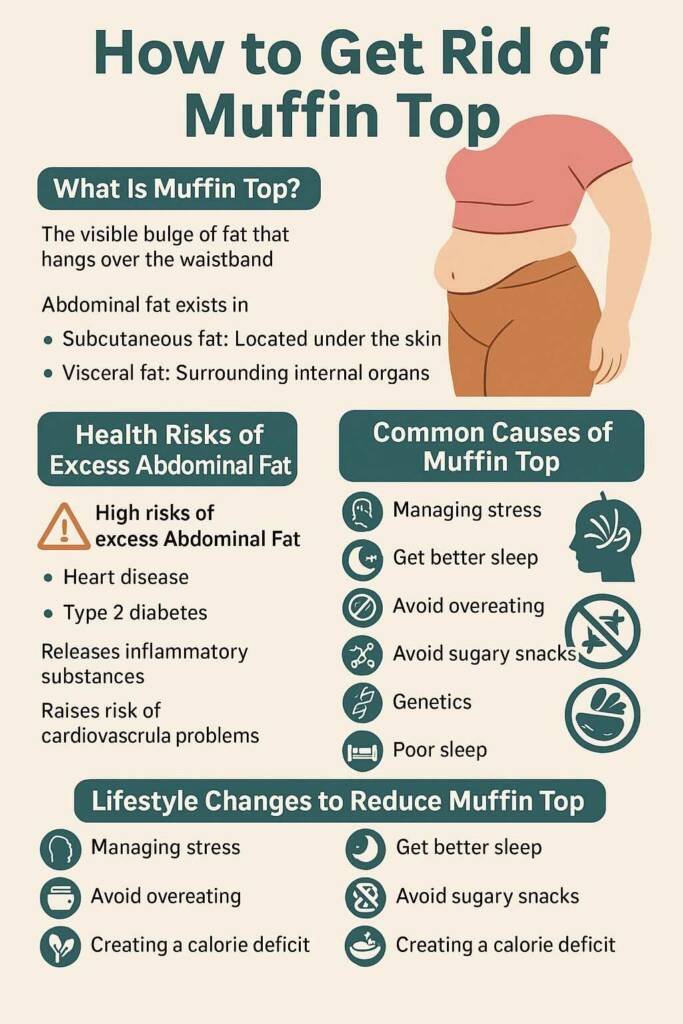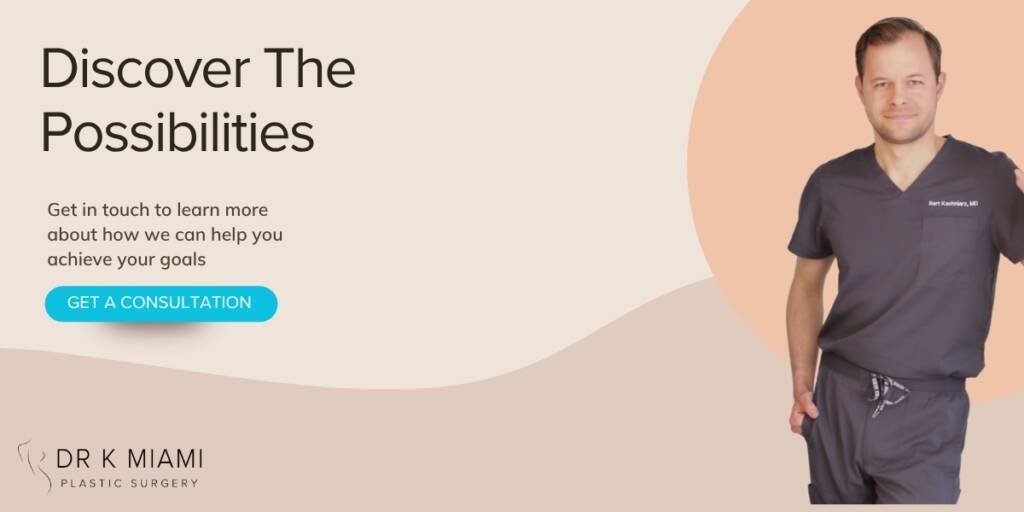Excess fat around the waistline, commonly called “muffin top,” affects millions of people and represents one of the most challenging areas to target for fat loss. This stubborn fat accumulation occurs when excess tissue spills over the waistband of clothing, creating an unflattering silhouette that many find frustrating to address.
The most effective approach to eliminating muffin top combines targeted core exercises, cardiovascular training, and strategic nutritional changes to reduce overall body fat while strengthening the underlying muscles.
When diet and exercise alone don’t achieve desired results, liposuction offers an alternative method for fat removal.
Understanding the science behind belly fat storage helps individuals develop realistic expectations and sustainable habits. Factors such as hormones, stress levels, sleep quality, and dietary choices all influence how the body stores and burns fat around the midsection, making a multifaceted approach essential for long-term success.
What Is A Muffin Top?
A muffin top is the visible bulge of fat that hangs over the waistband of pants, skirts, or underwear. This excess belly fat gets its name from resembling the way a muffin spills over the top of its paper liner.
The term encompasses what many people call love handles – the fat deposits on the sides of the waist. Muffin top becomes more pronounced when wearing tight-fitting clothing.
Abdominal fat exists in two distinct forms:
- Subcutaneous fat: Located directly under the skin and visible from the outside
- Visceral fat: Surrounds internal organs deep within the abdomen
Subcutaneous fat creates the soft, pinchable layer that forms the muffin top appearance. Visceral fat remains hidden but proves more dangerous to health.
Both types contribute to the muffin top phenomenon. The combination creates the characteristic bulge that extends past the natural waistline.
Health Risks of Excess Abdominal Fat
Excess belly fat significantly increases the risk of serious health conditions. Visceral fat poses the greatest threat because it releases inflammatory substances into the bloodstream.
Heart disease risk escalates substantially with increased abdominal fat. The fat tissue produces hormones and chemicals that affect blood pressure and cholesterol levels.
Type 2 diabetes develops more frequently in people with excess belly fat. Visceral fat interferes with insulin function and glucose metabolism.
Key health risks include:
| Condition | Risk Level |
| Heart disease | High |
| Type 2 diabetes | High |
| Stroke | Moderate to High |
| High cholesterol | Moderate |
| Liver disease | Moderate |
| Sleep apnea | Moderate |
Abdominal fat also contributes to high blood pressure and increases inflammation throughout the body. These factors compound cardiovascular risks significantly.
Common Causes of A Muffin Top
Multiple factors contribute to muffin top development. Poor diet ranks as the primary cause, particularly consuming processed foods high in sugar and unhealthy fats.
Stress triggers cortisol release, which promotes fat storage around the midsection. Chronic stress leads to overeating and cravings for high-calorie foods.
Hormonal changes affect fat distribution patterns. Estrogen fluctuations during menopause cause women to store more fat in the abdominal area.
Primary causes include:
- Consuming excess calories from processed and sugary foods
- Sedentary lifestyle with minimal physical activity
- Chronic stress and elevated cortisol levels
- Hormonal imbalances, especially during menopause
- Genetics determining individual fat storage patterns
- Poor sleep quality disrupting hunger hormones
Age-related metabolism changes reduce the body’s ability to burn calories efficiently. This natural slowdown makes abdominal fat accumulation more likely without lifestyle adjustments.
Lifestyle Changes to Reduce a Muffin Top

1. Managing Stress
Chronic stress elevates cortisol levels, which directly promotes fat storage in the abdominal area. High cortisol triggers the body to store more visceral fat around the midsection, making muffin top more pronounced.
Effective stress management techniques include:
- Meditation or deep breathing exercises
- Regular physical activity to reduce cortisol
- Time management to prevent overwhelming schedules
- Yoga or stretching routines
2. Get Better Sleep
Sleep deprivation compounds this problem by disrupting hunger hormones. When people don’t get enough sleep, their bodies produce more ghrelin (hunger hormone) and less leptin (satiety hormone).
Most adults need 7-9 hours of quality sleep per night to maintain healthy hormone balance. Sleep-deprived individuals often crave high-calorie foods and struggle with portion control.
Poor sleep quality affects metabolism and makes it harder to burn calories efficiently. People who consistently get enough sleep maintain better weight control and experience less abdominal fat accumulation.
3. Avoid Overeating
Overeating creates a caloric surplus that the body stores as fat, particularly around the waistline. Consuming more calories than the body burns forces excess energy into fat storage.
Key strategies to prevent overeating:
- Use smaller plates to control portions
- Eat slowly and chew thoroughly
- Stop eating when 80% full
Drinking more water helps reduce hunger signals and prevents mistaking thirst for hunger, which often leads to unnecessary snacking.
4. Avoid Sugary Snacks
Sugary snacks cause rapid insulin spikes that promote abdominal fat storage. These foods provide empty calories without nutritional value, making it easy to exceed daily calorie needs.
Processed foods often contain hidden sugars, unhealthy fats, and excess sodium that contribute to bloating and fat accumulation. These items are typically calorie-dense but nutrient-poor.
Foods to limit or avoid:
- Candy, cookies, and pastries
- Sugary beverages and sodas
- Fast food and fried items
- Packaged snacks with added sugars
5. Creating a Calorie Deficit
A calorie deficit occurs when calorie intake remains below daily energy expenditure, forcing the body to use stored fat for fuel. This fundamental principle drives all successful fat loss, including muffin top reduction.
Track calorie intake using food logging apps or journals for at least one week to establish baseline consumption patterns. Most people underestimate their actual intake by 20-40%.
Calculate your daily calorie needs using this formula:
- Women: BMR = 655 + (4.35 × weight in lbs) + (4.7 × height in inches) – (4.7 × age)
- Men: BMR = 66 + (6.23 × weight in lbs) + (12.7 × height in inches) – (6.8 × age)
Multiply BMR by activity factor (1.2-1.9) to determine maintenance calories. Create a moderate deficit of 300-500 calories daily for sustainable fat loss of 1-2 pounds per week.
Focus on reducing liquid calories from sugary drinks and alcohol, which contribute significantly to belly fat accumulation. Replace these with water, herbal tea, or sparkling water with lemon.
6. Exercises
Core Exercises
Bicycle crunches rank among the most effective abdominal exercises for targeting both the rectus abdominis and oblique muscles. The practitioner lies on their back, alternating knee-to-elbow movements in a pedaling motion.
Side planks specifically target the oblique muscles that form the muffin top area. Holding this position for 30-60 seconds per side builds strength and stability.
Mountain climbers combine core activation with cardiovascular benefits. The exercise begins in a plank position, rapidly alternating knee drives toward the chest.
Traditional crunches and plank variations provide additional core strengthening. These abdominal exercises should be performed 3-4 times per week for optimal results.
Strength Training
Compound movements burn more calories than isolation exercises while building lean muscle mass. Squats, deadlifts, and rows engage multiple muscle groups including the core.
Full-body strength training increases metabolism for 24-48 hours after exercise. This extended calorie burn helps reduce overall body fat percentage.
Progressive overload ensures continued results. Adding weight, reps, or reducing rest time challenges the body and prevents plateaus.
Strength training builds the lean muscle necessary for achieving a flat stomach. The increased muscle mass elevates resting metabolic rate, supporting long-term fat loss goals.
When to get Surgery for A Muffin Top?
Surgical intervention becomes necessary when stubborn fat persists despite consistent efforts.
Body contouring procedures offer permanent solutions but require careful evaluation of candidacy and potential risks.
When Diet and Exercise Aren’t Enough
Some individuals maintain healthy eating habits and regular exercise routines yet struggle with persistent fat around the midsection. This stubborn fat often resists traditional weight loss methods due to genetic predisposition and hormonal factors.
The body stores fat differently across individuals. Certain areas, particularly around the waistline, contain fat cells that respond poorly to caloric deficits and physical activity.
Hormonal influences play a significant role in fat distribution. Estrogen fluctuations, cortisol levels, and insulin resistance can promote fat storage around the abdomen regardless of overall fitness levels.
Age-related metabolic changes further complicate natural fat reduction. As metabolism slows, the body becomes less efficient at burning stored fat in problem areas.
Muffin top surgery targets these resistant fat deposits directly. Procedures like liposuction can remove fat cells permanently, providing results that diet and exercise alone cannot achieve.
Am I A Candidate for Surgery
Suitable candidates maintain stable body weight within 20 pounds of their goal. Fluctuating weight can compromise surgical results and increase complication risks.
Good candidates possess realistic expectations about outcomes. They understand that surgery addresses specific areas rather than providing overall weight loss solutions.
Physical health requirements include:
- No active medical conditions affecting healing
- Non-smoking status or willingness to quit
- Adequate skin elasticity for proper contouring
Mental readiness proves equally important. Candidates should pursue surgery for personal satisfaction rather than external pressure or unrealistic aesthetic goals.
Age considerations matter for optimal results. Most plastic surgeons recommend waiting until after childbearing years for women, as pregnancy can reverse surgical improvements.
Financial stability ensures proper aftercare and follow-up treatments. Quality procedures require investment in both surgery and recovery support.
Liposuction for Muffin Top Removal
Liposuction effectively removes stubborn fat deposits around the waistline that create the muffin top appearance. This surgical procedure targets fat cells that resist diet and exercise, offering permanent contouring results when performed by an experienced plastic surgeon.
Liposuction removes fat cells permanently from problem areas around the waistline, specifically targeting the abdominal fat that accumulates above the belt line and creates the characteristic overhang that bulges over clothing.
The muffin top area responds particularly well to liposuction because it consists primarily of subcutaneous fat—the pinchable layer directly beneath the skin. This type of fat can be effectively suctioned out, unlike visceral fat that surrounds internal organs deeper in the abdomen.
The waistline and flanks contain fat cells with alpha-receptors that make them particularly resistant to traditional fat loss methods. These stubborn deposits often persist even in individuals who maintain healthy body weight and exercise regularly, making liposuction an effective solution for bypassing this biological resistance by directly removing the problematic fat cells.
How Liposuction Targets Stubborn Fat
Liposuction achieves results that natural weight loss cannot because it physically removes fat cells from targeted areas. When you lose weight through diet and exercise, fat cells shrink but remain in place, and these cells can later expand again with weight gain. Liposuction permanently eliminates these cells, meaning they cannot return or regenerate.
A plastic surgeon inserts a thin cannula through small incisions to break up and suction out fat cells. The technique allows precise contouring of the waistline while preserving natural body curves.
Key targeting areas include:
- Love handles (flanks)
- Upper abdominal region
- Lower back fat
- Hip area fat deposits
The procedure works best for patients with good skin elasticity. Stubborn fat deposits that remain despite healthy lifestyle habits respond well to liposuction techniques.
Surgeons can remove significant amounts of fat while maintaining symmetrical results. The muffin top area allows for aggressive fat removal without causing contour irregularities.
Recovery Timeline
Recovery involves wearing compression garments for 4-6 weeks. Patients experience swelling and bruising that gradually subsides over several weeks.
Timeline breakdown:
- Week 1-2: Return to work and light activities
- Week 2-3: Resume moderate exercise
- Week 4-6: Full activity clearance
- 3-6 months: Final results visible
Most patients take 1-2 weeks off work depending on their job requirements. Pain medication helps manage discomfort during the initial recovery period.
When Would I need a Tummy Tuck?
A tummy tuck surgically removes excess skin and fat while repairing separated abdominal muscles that cannot be addressed through liposuction alone. This comprehensive procedure specifically targets structural issues that develop after pregnancy or significant weight loss when collagen and elastin have been permanently damaged.
Determining whether you need a tummy tuck rather than liposuction depends on the specific condition of your abdominal area. Several key indicators suggest a tummy tuck may be necessary:
- Excess loose or hanging skin that creates folds or apron-like appearance below the belly button. This commonly occurs after pregnancy or weight loss exceeding 50 pounds, when the skin has been stretched beyond its ability to retract naturally.
- Visible muscle separation or a protruding belly that remains even at a healthy weight. Diastasis recti creates a ridge down the center of the abdomen and causes the stomach to pooch outward despite minimal body fat.
- Stretch marks concentrated below the navel that cannot be improved through non-surgical methods. A tummy tuck removes this damaged skin entirely rather than attempting to tighten it.
- Failed results from liposuction where fat removal has revealed underlying skin laxity or muscle weakness. Some patients discover they need more comprehensive correction only after trying less invasive options.
- Post-pregnancy changes that persist 6-12 months after childbearing. Women who have carried multiple pregnancies or twins often develop both muscle separation and skin damage requiring surgical repair.
The ideal tummy tuck candidate has completed their family planning, maintains a stable weight, doesn’t smoke, and has realistic expectations about surgical outcomes and recovery time. Patients should be within 10-15 pounds of their goal weight before considering this procedure.
How Does a Tummy Tuck Differs from Liposuction?
Liposuction only removes fat deposits beneath the skin. It cannot address loose skin or repair separated abdominal muscles.
A tummy tuck provides comprehensive correction by removing both excess skin and fat. The surgeon makes a horizontal incision between the pubic area and belly button to access the treatment area.
Key differences include:
- Muscle repair: Tummy tucks tighten separated abdominal muscles by plicating them like a corset
- Skin removal: Excess skin is surgically excised rather than left in place
- Incision size: Larger incision required compared to liposuction entry points
- Recovery time: Longer healing period due to muscle repair component
Patients with significant loose skin after pregnancy typically require abdominoplasty rather than liposuction alone.
Recovery
Initial recovery requires 2-3 weeks off work for desk jobs. Physical activity restrictions last 6-8 weeks to allow proper muscle healing.
Patients wear compression garments for several weeks. This reduces swelling and supports the newly positioned tissues during healing.
Recovery timeline:
- Week 1-2: Limited mobility, pain management
- Week 3-4: Return to light activities
- Week 6-8: Resume exercise gradually
- 3-6 months: Final results visible
Long-term success depends on maintaining stable weight. Significant weight fluctuations can compromise results by stretching the repaired muscles and remaining skin.
The surgical results are generally permanent when patients maintain their post-surgery weight within 10-15 pounds.

Non-Surgical Alternatives
CoolSculpting uses controlled cooling to freeze stubborn fat cells, while radiofrequency and laser treatments offer additional body contouring options with minimal downtime and recovery compared to surgical procedures.
CoolSculpting
CoolSculpting uses cryolipolysis technology to freeze fat cells at precisely controlled temperatures. The treatment targets stubborn fat deposits by cooling them to a point where the fat cells die while leaving surrounding tissue unharmed.
During treatment, an applicator suctions the targeted area and delivers controlled cooling for 35-60 minutes. The frozen fat cells gradually break down and are naturally eliminated by the body over 8-12 weeks.
Common treatment areas include:
- Lower abdomen (muffin top area)
- Love handles and flanks
- Upper abdomen
- Back fat
CoolSculpting typically reduces fat by 20-25% per session in treated areas. Most patients need 2-3 sessions spaced one month apart to achieve optimal results for muffin top reduction.
The procedure requires no anesthesia or incisions. Patients can read, work on devices, or relax during treatment sessions.
Pros and Cons of Non-Invasive Options
Advantages of non-surgical body contouring:
| Benefit | Details |
| No downtime | Return to normal activities immediately |
| Lower cost | $600-$1,500 per session vs $6,000+ for surgery |
| Reduced risks | No anesthesia or surgical complications |
| Natural results | Gradual fat reduction over 2-3 months |
Limitations to consider:
Non-surgical treatments produce more modest results than liposuction. They work best for patients within 20-30 pounds of their ideal weight with localized fat deposits.
Multiple sessions are typically required. Results vary based on individual body composition and adherence to healthy lifestyle habits.
Radiofrequency treatments like TruSculpt and laser options such as SculpSure offer alternatives to cryolipolysis. These methods use heat rather than cold to destroy fat cells and may provide additional skin tightening benefits.
Cosmetic Surgery With Dr K Miami
Taking the first step toward eliminating your muffin top begins with a comprehensive consultation. Dr. K Miami specializes in body contouring procedures designed to help patients achieve their aesthetic goals when diet and exercise alone aren’t enough.
This personalized assessment determines whether liposuction, a tummy tuck, or a combination approach will deliver optimal results. Dr. K takes time to explain each procedure option, including the techniques involved, expected outcomes, recovery timeline, and potential risks.
Schedule Your Consultation Today
Don’t let stubborn muffin top affect your confidence any longer. Contact Dr. K Miami to schedule your private consultation and discover which body contouring solution can help you achieve the sculpted waistline you desire. The consultation provides honest, professional guidance about realistic expectations and the best path forward for your specific situation.



